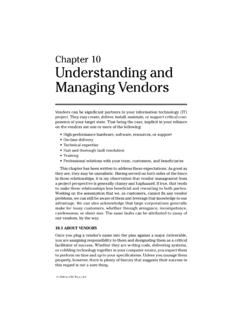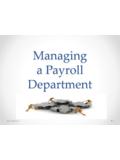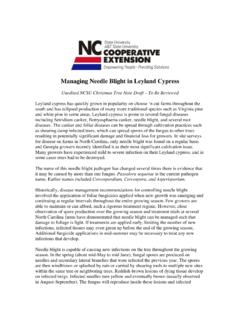Transcription of Managing operational tax risk - EY
1 Managing operational tax riskFind the right people, processes and technology to manage record-to-report risks2014 Tax Risk and Controversy Survey seriesManaging operational tax riskThis report is the second in a series discussing EY s global 2014 Tax Risk and Controversy Survey. Using the survey results, inputs from tax function leaders and EY professionals, it provides a deeper exploration of the many sources of operational tax risk. We define operational tax risk as those risks arising inside the organization from people, processes and technology. The report concludes with a series of detailed actions for companies to consider adopting, which together make up a framework for operational tax risk management. We hope this series will be your guide for your journey up the mountain and safely down the other side. To access other reports in the series, please visit or connect with your local EY Tax 1 People and organization 5 Policies, processes and controls 13 Using technology to mitigate risk 21 The right tools for the climb 29 Conclusion 33 Tools and insights 341 Find the right people, processes and technology to manage record-to-report risks |IntroductionThe first report highlighting results from EY s 2014 Tax Risk and Controversy Survey1 compared Managing tax risk in the current environment to climbing a mountain.
2 It identified four heightened sources of risk reputation, legislative, enforcement and operational based on results from 962 tax and finance executives in 27 countries, including more than 130 chief financial The first source, reputation risk, is a relatively new phenomenon that has thrust tax onto the front pages and into the boardroom. Companies are wrestling with the reputational implications of demands for more transparency from a wide group of stakeholders that now includes national governments in addition to news media and social justice activist groups. They re also adapting to thresholds for satisfying public opinion, which can be very different than the technical thresholds required under tax See 2 The first report in this series, Bridging the divide, was based on survey results from 830 executives in 25 countries. Additional survey results have been collected since the publication of that report.
3 The second driver is legislative risk, from both the effects of the Organisation for Economic Co-operation and Development s Base Erosion and Profit Shifting (BEPS) project and from the myriad policy changes that cash-strapped governments continue to put in place. On BEPS, companies expressed skepticism that universal adoption of all recommendations is likely to occur. They were equally concerned that countries are moving unilaterally to pre-empt some provisions in an uncoordinated way. The net effect of these parallel developments is that 61% of the largest3 companies say they expect to face increased double taxation in coming enforcement risk is the third driver. Among other findings, many companies in the survey reported more frequent and aggressive tax audits; 63% of Americas-based companies said they have experienced difficulty in securing pre-filing rulings or Advanced Pricing Agreements, and a significant proportion 67% said they also feel their efforts to foster a more open and cooperative relationship with tax authorities have been unrequited in recent years.
4 Those three sources will be the subject of subsequent reports. This report focuses on operational tax risks the many internal challenges that companies face in achieving an accurate record-to-report process for their tax and statutory reporting The largest companies reported more than US$5 billion in revenues. It s always further than it s always taller than it it s always harder than it looks. The three rules of mountaineering2| Managing operational tax risk This fourth driver of tax risk has wide ramifications for businesses large and small; every company has to deal with it, and few do it with absolutely certainty in such a changing landscape. Although there has been a steady decline in the number of material weaknesses specifically related to US generally accepted accounting principles (GAAP) since 2005, taxes continue to be the most prevalent of the US GAAP failures reported: more than 50% of tax material weaknesses reported in the United States today, for example, are driven by a lack of review, lack of personnel or poor process execution.
5 And operational risk covers not only financial statement reporting but all reporting to governments and governing bodies. For example, more than 60% of VAT errors leading to adjustments are due to mistakes such as incomplete invoices or receipts, or errors in applying tax has always been a challenge to get the right people, processes and technology in place to properly define, align and source the financial information that must be reported to regulators, investors and tax authorities in every business line and jurisdiction in which a company operates. In recent years, many companies have sought cost savings from their finance function by transforming those operations, centralizing and standardizing their processes and leveraging shared service centers and centers of excellence. These simultaneous demands of finance transformation, along with the other drivers of risk identified by the survey, layer new pressures on tax that must be managed.
6 Finance transformation is changing the face and the operating environment for a lot of the things for which tax is responsible, says Patrick Trapp, EY s EMEIA Director of Tax Performance Advisory. All of that changes the broad operating environment of the tax function. When the people, the processes, the technology or the data change, that puts those of you responsible for the quality of tax outcomes at risk. It is creating the number-one risk in my opinion, and it is happening everywhere. It is pervasive. Data integrity, in particular, is a core operational risk factor for every business. Often, day-to-day transactions booked in any given country are not properly sensitized for tax purposes; accounts may not be used for the correct purposes or changes may go uncommunicated. The difference in tax treatment between a normal everyday accrual and a major restructuring reserve, for example, can be immense.
7 Ensuring data integrity goes from basic controllership of general ledger (GL) accounts right through to making sure that the right people are pooling together legal entity ledgers to support effective tax and statutory accounting. For companies with multiple lines of business and a presence in dozens, if not hundreds, of jurisdictions, the problem of data integrity can grow exponentially. Automation of the tax audit process by some revenue authorities is compounding these risks ; the increasing use of IT-driven auditing such as the growing European phenomenon of Standard Audit Route signsOn any trek, flags and signs mark the route for safe passage. The illustrations in the margins of this report both tell a story of their own and complement the text. However you use them, they are designed to enrich your report and accompanying graphics make references throughout to largest and large companies.
8 Largest refers to global companies with more than US$5 billion in annual revenues, and large refers to global companies with revenues in excess of US$250 the right people, processes and technology to manage record-to-report risks |Files for Tax, or SAF-T, means that one wrongly booked transaction can ripple through multiple calculations, causing incorrect results and new tax our mountain climbing analogy, the three external drivers of risk identified by the survey reputational, legislative and enforcement equate roughly to unpredictable and uncontrollable hazards such as avalanches, frostbite and whiteouts at high altitude. operational risk, on the other hand, is all about having the right gear, the right plan and the right support team to reach the summit successfully. Many risks are not arguments around deep, tax technical interpretation but instead about whether your can build and sustain an organization that finds and corrects errors before they get out of control says David Helmer, Global Director of Business Tax Services.
9 Candidly, you need to ask yourself whether you are thinking deeply enough about how you can position your tax function in a way that enables them to manage these operational risks . This report showcases survey findings about specific challenges tax professionals say they re facing across the dimensions of people, processes and technology within their enterprise. Using survey responses and a number of insights from tax leaders in different companies, it examines what companies are doing with the resources they have now, as well as how they build flexibility and resilience. It also investigates the divide that some companies may have to cross as they move from current to future tax risk management , we identify eight key components of an optimal tax framework that can be adopted to mitigate operational risks and achieve control, value and efficiency across the entire record-to-report and More than 50% of tax material weaknesses reported in the United States are driven by a lack of review, lack of personnel or poor process execution.
10 More than 60% of VAT errors leading to adjustments are due to mistakes such as incomplete invoices or receipts or errors in applying tax rates. Leading sources of operational tax risk for the largest companies (in order of prevalence): 75% cited insufficient resources to cover tax function cited insufficient internal cited a lack of process or technology.| Managing operational tax risk 4| Managing operational tax risk 5 Find the right people, processes and technology to manage record-to-report risks |organizationThese words of US businessman Harold Geneen are particularly true when it comes to effectively performing the complex tasks that companies hope will result in timely, accurate and sound statutory and tax are the lifeblood of an effective tax function. The skills and competencies they possess, how they are deployed, and the relationships they have with each other and with other business functions are all vital to successfully Managing operational tax risk.

















